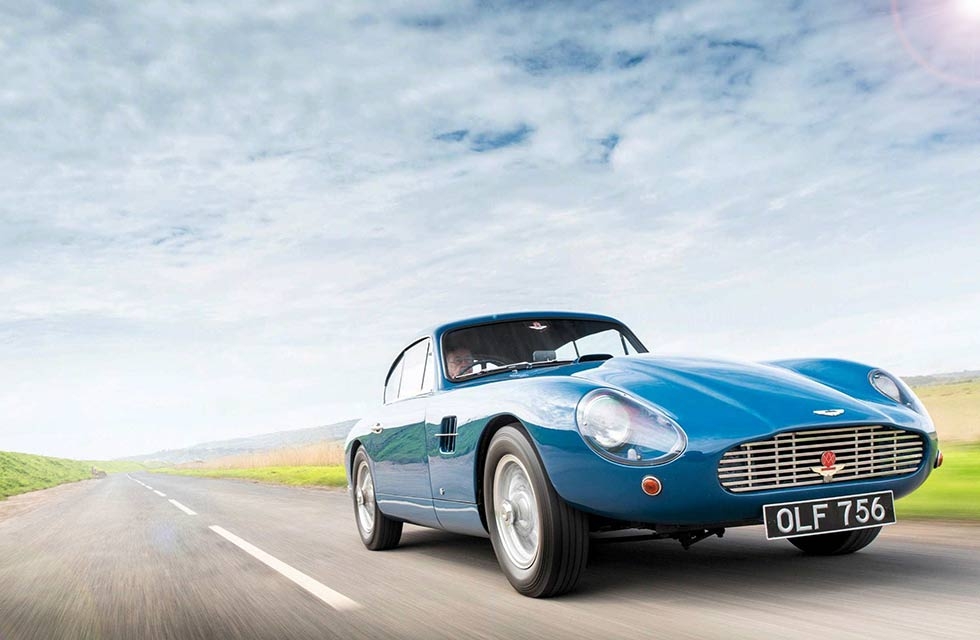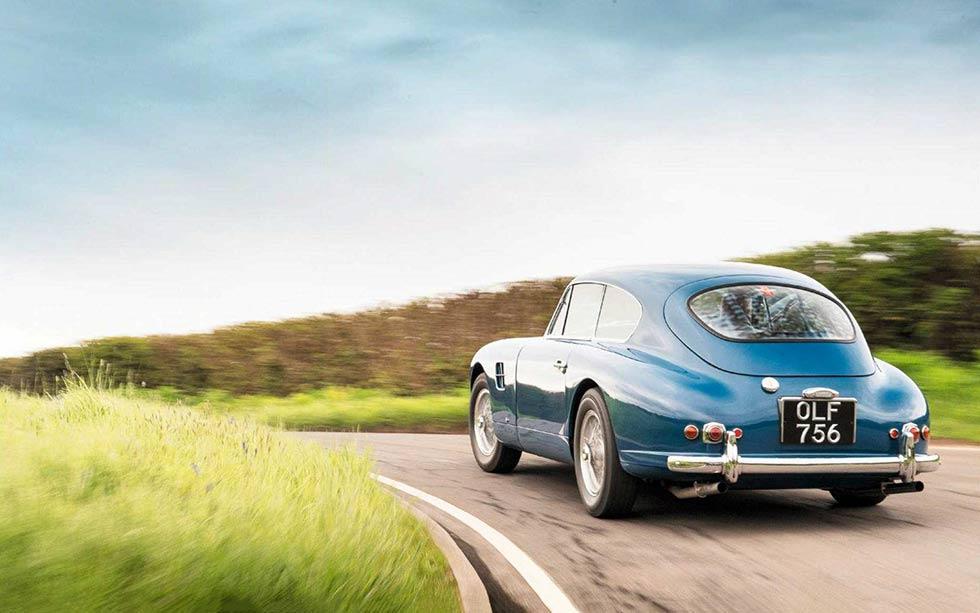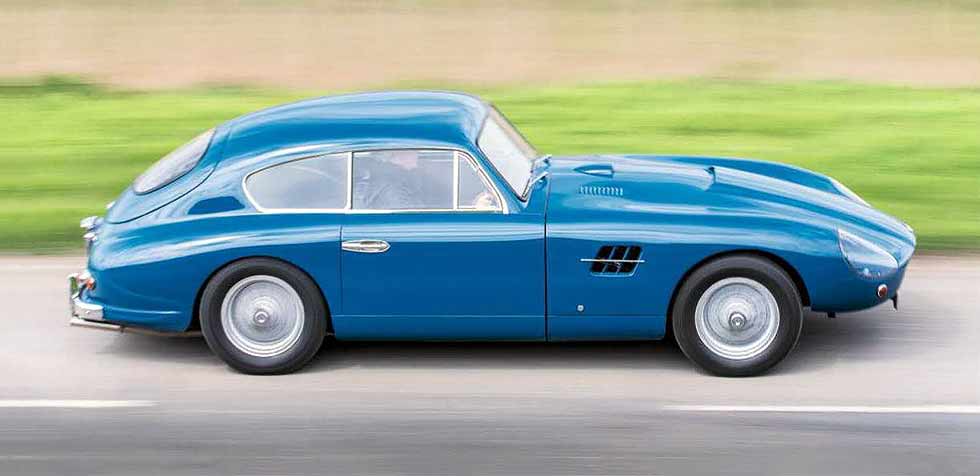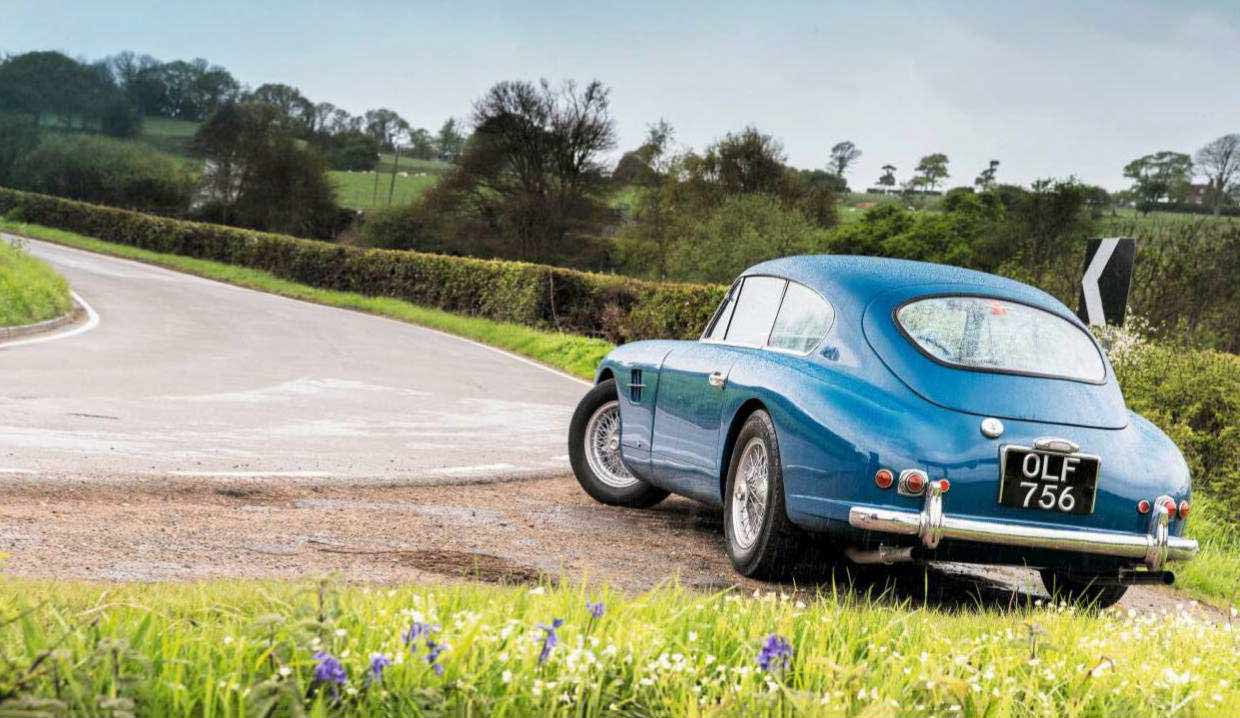
We Could Be Heroes The curious tale of an Aston Martin DB2/4 reworked for low-drag racetrack competition by a mystery coachbuilder. This is a car that evokes the very spirit of the true-blue Brit hero. But a glance tells you this is no ordinary Aston DB2/4; we delve into this unique example’s history. Words Rob Scorah. Photography Adam Shorrock.
UNIQUE ASTON Special-bodied DB2/4 driven
Oh wow, look – there’s a… oh, a…? Yes, you’re not sure, are you? The back end, with that E-type pre-empting hatch, is telling you Aston Martin DB2/4. But the front end? Well, that’s telling you Aston as well, but it’s as if somehow time has spiralled back and this is an evocation of cars yet to come – the DB7 perhaps, complete with muted bonnet hump and sultry mouth.

Looking at that long Sixties-esque nose, and without seeing the badge, you could have so many thoughts. A proto-Griffith perhaps, or even Osca/ Alfa (long shot maybe). It is actually an Aston Martin DB2/4 with a custom, coach-built snout. When you sit behind it, the vents and scoops looking back at you, it begins to colour your vision of how the car might drive and handle. Is there such a thing as approaching a classic car objectively?
There very likely isn’t. And anyway, I probably never want to do such a thing. I want to be told stories by it, to feel the car, to feel things other machines can’t give me, not even other classic cars. And I want somehow to ‘sense’ that badge – Aston Martin. Sitting behind the big, rather upright steering wheel – arms bent, elbows almost at my sides – the car immediately has a bespoke feel. That is, once you’ve climbed/slid/limboed in. For a gentleman’s carriage, there’s a fair bit of high-sill, low steering wheel ducking and sliding to be done.
Once there, there’s that whole English thing going on in the cabin – the deep, rich walnut burr (though as yet not fully extended across the scuttle) and those large, white-on-black Smiths clocks. And probably, if you’re to maintain control at the wheel without strain creeping across your chest from the unassisted steering, you’ll maintain that upright Englishness. But then again your legs will lie comparatively flat to a close floor. That isn’t to say straight if you’re tall.

It’s a little bit like settling into a pair of once-expensive and well cared-for brogues you’ve found in some eccentric boutique. Wish I’d worn a hacking jacket now.
But if I’m not careful I’ll quickly get sidetracked by half-reflexive, secondhand references to those I imagined once drove such a beast – British heroes, real or imagined, like Richard Hannay or Bulldog Drummond. And, of course, James Bond bombing down the A2 in a DB2/4 in Goldinger (the book, that is). Well, thank you gentlemen, but I’ll leave it there. I’ll do my own bombing, and try and take my cues from the automobile itself. Luckily this is something that’s not difficult to do.
This is one of those cars in which, at least taking it moderately, the engine thrums. I’m not sure I’ve really got a clue what that word means, but if you say it long enough in quick succession, you get a vague approximation of how this motor sings as it lopes along – it’s rhythmic, even, burring in a low tenor register, taking small pushes to the pedal with equanimity, a mutedly busy thrashiness tapping along over the darker tones.
It is, in tone, the very model of an English six, designed as it was by another English hero, WO Bentley. It eschews the brawling burble of the American V8 and pulls up short of the coloratura of an Italian V12. If I keep my foot moderately placed, maintaining 2000rpm or so, there’s a watch-like quality to its metre that brings to mind Breguet or vintage Longines – sounds that are even and predictable, shaped by measured and constant mechanical operation. Like those watches, it’s seductive. You’re quite happy to amble on for miles listening to the mechanical discourse. You can chat, swap stories… listening to the radio would be sacrilege.
Promenading in an old Aston is wonderful of course, but beneath the equanimity, quite close to the surface you can feel an innate gutsiness. There’s just something in the push of the pedal that quickly translates into grunt. The car doesn’t make a big show about it, it remains reserved, but when you want to go, it obliges – and in any car with power, you want to go.
A deliberate prod brings forth more thrashiness, a more jagged growl and immediate movement. With a ‘racing downchange’, old Bond would have been quickly overtaking all those Morris Oxfords and Ford Zephyrs on the A2.
At 2000rpm it’s an easy 40mph, and even with a relaxed slotting from third to second, the resulting 3000rpm will quickly take you to 60mph-plus. I’m impressed by the ease of moving between gears – a snickety, mechanical feel, although I wish there were an overdrive to calm things a little when cruising at higher speeds. Very quickly you feel at ease with where the power lies and can easily bring it forth with a quick change or a stab of throttle.

I think at first I was driving this car like a DB5 or 6. If you’re not careful everything ‘Aston’ is referenced by the DB5, but the more I’m in this car the more both mine and the DB2/4’s operation and reaction times are shortening. The revelation to me is that this is a sports car not a GT, and I’m having more fun driving it as a sports car – going tighter into the turns and quicker out of them, it remains poised with little roll. I’m doing more downchanges, holding the gears longer. This car is basically riding on the Claude Hill chassis design that won the 1948 Spa 24-hour.
I’m getting that long-distance dash feeling; imagining driving hard through a rainy night or over the Dolomites, a pipe clenched in the corner of the mouth job. Oh dear, you’ll have to excuse me – I’m regressing into that Forties/Fifties hero quest thing again. The DB2/4 has a certain gruffness, perhaps even a veiled, but never unleashed, brutishness.
It’s a car I’d be happy to do the Mille Miglia in; it has that kind of chuckability you get from cars that aren’t too big. All the controls are close, just where you want them, with well-spaced pedals – though they’re not great for heel and toeing – and the gearshift hard by your left hand. And the steering? Well, here’s the thing – that’s good too. Should I sound surprised? Frankly, yes.
You have to remember that the parent companies of David Brown – the man who bought and merged Aston and Lagonda – made, among other things, agricultural gearboxes and tractor/ dumper components. And sometimes, just sometimes, with Feltham-era Astons (and even with later DBs) you reckon, by the feel of things, that a few too many tractor bits might have been tipped into the mix – like the steering rack, for instance.
However, I don’t believe I happen to have got lucky and be driving a ‘good ’un’, but rather a good ’un bought this Aston and fettled it properly. Its owner, Peter Brown, is a retired engineer who, as a teenager, benefited from an informal apprenticeship at the garage-cum-race preparation shop of Bromley-based mechanic Roland York. Alongside general motor engineering, York taught him the finer points of suspension geometry and the inner mysteries of differentials. So – about that steering?
‘Well,’ smiles Brown, ‘like everyone else at that time David Brown used what was available, so basically the DB2 had the same steering as a Thwaites dumper truck. In the Fifties that was probably OK, but with new radial tyres and modern tolerances it didn’t feel very good at all.’
Brown took the DB’s steering box to Silverstone-based specialists GSW which re-engineered/re-manufactured the meshing components. ‘They changed from phosphor bronze to needle bearings,’ he adds. ‘Of course, the steering’s an old design – there are a lot of linkages.’
It doesn’t feel that way now. The nose is faithfully following the turn of the wheel into the bends – and what’s more, as the radius tightens there doesn’t seem to be that huge exponential rise in heft as I bring it round. Apparently he also tweaked the castor from two and a half to three degrees ‘for less effort’.
There’s also a plantedness about the car, the feeling that all four tyres are going to stay on the road whether the gradient and camber change or not. Like the steering, the suspension has been tweaked, the damper and spring settings optimised. This car is actually the third Aston that Brown has fettled and tweaked, so he is rather getting the hang of it.

However, he didn’t have a lot of choice but to fettle the DB2/4. It arrived at his house in the Seventies as two trailer-loads of bits from a deceased estate, lacking a crankshaft and interior trim. ‘When we first got hold of it, it was a hobby car for me. We’d just started a new business, so it was basically something to occupy my mind in the evenings,’ he remembers. ‘It had been totally stripped out as a competition car. It had an Astrali steering wheel and a single resin bucket seat.’
It would take him and his wife four years to piece the car back together, buying what were, back then, simply secondhand Aston Martin spares, and finding or remaking some interior parts along the way.
Almost all of the aluminium body panels had been damaged and dented by children playing in the barn where the car had been laid up, so he had to hammer them out and repair them. The couple discovered scraps of the car’s original colour of Teal Blue, and repainted it in a non-authentic but more period-appropriate looking non-metallic rendering of it. And did they add the custom DB7 evocation nose?
‘Oh no,’ says Brown. ‘That was a period modification.’
Unfortunately, details of its commissioning and manufacture are lost to history, though there is a picture of it in the paddock at Silverstone in ’1966. The one clue about the snout’s fabrication that surfaced in restoration is that it is of multi-panel construction, suggesting Italian craftsmanship rather than one-piece English. Perhaps if whoever had made this nose had banged out a few more – as he probably did for other marques in his shirt sleeves with a fag in the corner of his mouth – we’d be talking about the Aston Martin Fangonelli or the DB2/4 Valbone, or whatever his name was. If they’d raced it (beyond the club events this car took part in), maybe it would be the Aston DB2/4 Sebring or some such. ‘Have you ever driven a DB2/4 Sebring?’
‘Oh yes, magnificent thing.’
As it is, it remains a curiously prescient one-of, and a car that’s so much more racy than the rather matronly standard version, with a dynamic character nearer to what you’d hope such a silhouette would offer. Like Bond or Drummond, its persona carries echoes of things that never were, but its aura and abilities still have great resonance in the real world.
TECHNICAL DATA FILE SPECIFICATIONS 1953 Aston Martin DB2/4 MkI
Engine 2922cc, in-line six-cylinder, OHV, twin SU carburettors
Max Power 140bhp @ 5000rpm / DIN (nett)
Max Torque 178ft lb @ 6300rpm / DIN (nett)
Transmission Four-speed manual, rear-wheel-drive
Steering Worm and nut
Suspension Front: independent, trailing arms, coil springs, hydraulic dampers. Rear: live axle, trailing arms, radius arms, coil springs, lever-arm dampers, Panhard rod
Brakes Drums front and rear
Weight 1250kg (dry)
Performance
Top speed: 120mph
0-60mph: 11.1sec
CC Price Guide £65k-£185k
‘The revelation to me is that this is a sports car not a GT, and I’m having more fun driving it as a sports car’
Bespoke DB7-like snout was an in-period modification dating back to at least 1966. Sprightly straight-six is a tribute to designer WO Bentley. The car’s steering has been brought to 21st Century standards Almost all the panels had to be hammered straight after years as a kids’ plaything Interior parts had to be sourced secondhand or fabricated.
Elegant cabin belies the car’s history – it was stripped out for racing before restoration. Owner-restorer Peter Brown services the car every 3000 miles. It took Peter and his wife four years to gather original parts to return the car to standard. The origins of that nose are lost in the mists of time – but surely it exudes an Italian aura? From this angle only the ventilation gills hint that this is an exceptional DB2/4.
Looking after a 1953 Aston Martin DB2/4
‘You have to apply the standards of the period when looking after these cars,’ advises Peter Brown. ‘Don’t merely look on it as a car that’s going well, so it doesn’t need such frequent checking.
‘We used to do about 5000 miles a year, but now it’s more like 3000. I change the oil – making sure it’s a proper classic oil – and filter, plugs and points every year, and grease up the various nipples every three to four months to prevent gravel getting into the ball joints. I also change the oil in the differential and the gearbox.’ He reckons it only costs him about £200 to £300 a year in maintenance costs, but of course, he does all the work himself.
‘So far the only body parts I’ve needed since putting the car back on the road in 1979 are new headlight covers after someone backed into the nose. The insurance company stipulated polycarbonate composite and these had to be custom made.’ However, as Peter stresses, this would apply to any of the alloy body panels too, should they ever be needed. ‘The one-of nose doesn’t really make any difference – no one produces any of the body parts the way in which, say, BMH does for MGs. You’d have to start from scratch.’






